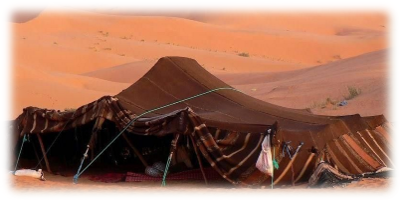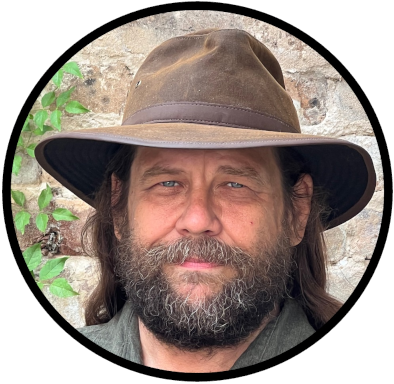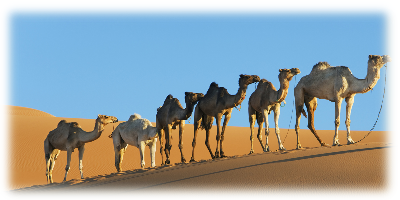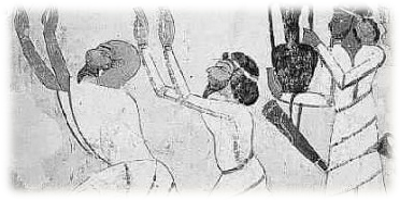The tent was divided into two parts. The main section, behind the tent door, is the men's section. The other section is the women's section, with a wall dividing the two parts. The only males allowed into the women's section are the father of the tent and children. Notice the similarity to the pictographic Hebrew letter beyt -  . The word beyt is not only the name of a letter but is also a common Hebrew word meaning, "home". This letter is a representation of the floorplan of the tent, the "home" of the nomadic Hebrews.
. The word beyt is not only the name of a letter but is also a common Hebrew word meaning, "home". This letter is a representation of the floorplan of the tent, the "home" of the nomadic Hebrews.
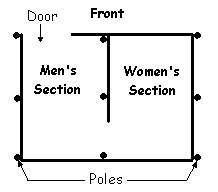
The entrance to the tent is covered by a curtain which hung down from the top of the entrance. The Hebrew word dal means "hang down" and is the root for the word dalet meaning "door". This word is also the name of another Hebrew letter -  , a representation of the tent door. The door of the tent is the most important part of the tent, not because of its appearance, but its function as the entrance into the tent. "He [Abraham] was sitting at the entrance of the tent as the day grew hot" (Genesis 18:1).. The door of the tent can be equated with the throne of a king. In the Hebrew culture, the father of the family is the "king", the one who holds full authority over the family. The father will often sit at his door much like a king will sit on a throne. All family legal matters were performed at the tent. Here he will watch over his household as well as watch for passing travelers. The nomadic rules of hospitality are very strict and complex.
, a representation of the tent door. The door of the tent is the most important part of the tent, not because of its appearance, but its function as the entrance into the tent. "He [Abraham] was sitting at the entrance of the tent as the day grew hot" (Genesis 18:1).. The door of the tent can be equated with the throne of a king. In the Hebrew culture, the father of the family is the "king", the one who holds full authority over the family. The father will often sit at his door much like a king will sit on a throne. All family legal matters were performed at the tent. Here he will watch over his household as well as watch for passing travelers. The nomadic rules of hospitality are very strict and complex.
Tents are constructed of black goat hair. "Dark am I....dark like the tents of Kedar, like the tent curtains of Solomon." (SS 1:5). The hair is spun into strands which are then woven together forming panels approximately 2 feet wide and the length of the tent. Over time, the panels begin to bleach from exposure to the sun and are periodically replaced. Very little is discarded as much work is invested in their materials including the tent. The pieces of the tent which are removed are recycled into walls or mats.
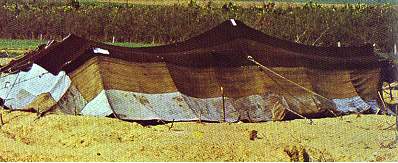
Another Hebrew letter derived from the tent itself is the letter Hhet, a word meaning "wall". This letter in the ancient pictographic script is  , a picture of a wall as can be seen in the above picture.
, a picture of a wall as can be seen in the above picture.
The size of the tent will depend on the size and wealth of the family. As the family grows, additional panels are added to increase the size of the tent. "Enlarge the place of your tent, stretch your tent curtains wide, do not hold back; lengthen your cords, strengthen your stakes" (Isaiah 54:2).
The goat hair tent is unique in that it is perfectly suited for the desert regions of the Near East.
Heat
A tent provided shade from the sun. During the strong heat of the day, the father would often sit at his door watching his family, livestock and the road for travelers (Genesis 18:1,2) The walls of the tent could be lifted to allow the breeze to pass through the tent.
Cold
The black tent absorbs heat keeping the tent warm. A fire is also built just inside the door for warmth.
Rain
Like any other cloth, there is space between the hair fabric. Light coming through the black roof appear as stars in the night sky. "He stretches out the heavens like a canopy, and spreads them out like a tent to live in" (Isaiah 40:22). When the hair fibers get wet from the rains, the fibers expand, forming a watertight roof.
Wind
Strong ropes, secured by pegs driven into the ground, supported the poles which held up the tent. "I will drive him like a peg into a firm place; he will be a seat of honor for the house of his father" (Isaiah 22:23). The word "firm" in the previous passage is the Hebrew word aman and is often translated as "believe". The walls of the tent are laid on the top of the ropes allowing the wind to pass over the tent. The Hebrew letter vav (or waw) -  is a representation of the pegs used to secure the tent. The word "vav" is also a word in the Hebrew language meaning "peg".
is a representation of the pegs used to secure the tent. The word "vav" is also a word in the Hebrew language meaning "peg".
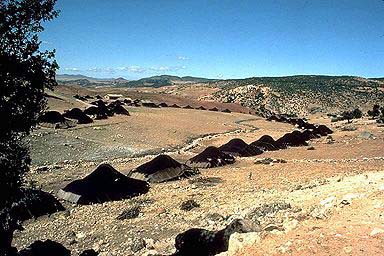
The Nomadic family consisted of the beyt (house, family), mishpechah (clan) and matteh (tribe). The family, children, parents and grandparents, all resided in one tent. The clan consisted of the extended family, grandparents, aunts, uncles, cousins, etc., all residing in one camp and may contain as many as 50 to 100 tents laid out in a circular pattern. When the clan becomes too large for one area to support, the tribe splits into two clans (see Genesis 13). All the clans (all being descended from one ancestor) may cover hundreds of square miles making up the tribe. As an example, the house of Moses, of the clan of Levi, of the tribe of Israel.
Hhanan is a Hebrew word often translated as "grace" but is Hebraicly understood as a "camp". The camp, as seen above, is a place of beauty, love, warmth and comfort.
Like what you’re discovering? Continue the journey from Bible reader to translator.
|



